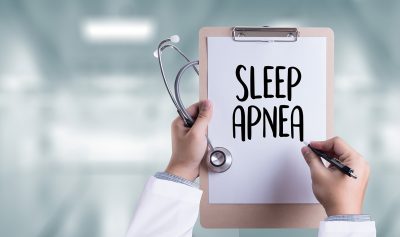When you picture sleep apnea treatment, a bulky PAP machine probably comes to mind. These popular — though not necessarily beloved — devices ensure the airway doesn’t close while you sleep and help with proper and consistent breathing. Though many people think PAP machines are the only option for sleep apnea treatment, researchers and doctors are making progress in other solutions as well — treatments that might change the standard for sleep apnea treatment in the next decade if scientists have anything to do with it.
Dr. Allison Brager, U.S. Army neuroscientist and author who specializes in sleep, explains that though the PAP might continue to be a major treatment option in the future, there could be changes to the device in the next decade. She also says that a pacemaker-like device to “stimulate esopharyngeal areas” is being explored now.
In addition, doctors are looking into comprehensive approaches for care. “Sleeping in the fetal position and not on the back or stomach [is important]. There is an at-home diagnostic device that tracks and monitors sleeping positions across the night,” she says.
What Treatments Are Currently Available?
The PAP machine, which hooks to the user’s mouth and nose at night in order to provide positive airway pressure, is one of the most reliable and consistently prescribed devices for (OSA).
“The gold standard for sleep apnea is CPAP. Why it is the gold standard is because OSA is caused by the airway collapsing during sleep and not letting air go through airways to the lungs and brain while you’re sleeping…so the gold standard is to open the airways,” says Dr. Carleara Weiss, Ph.D., MS, RN and Aeroflow Sleep’s Sleep Science Advisor. “But there are some alternatives, even to the [standard] CPAP. Some masks cover the mouth and nose, some just cover the nose to be more flexible and comfortable depending on the patient’s situation.”
The problem with PAP is essentially one of follow through — not many people want to strap it on their face and try to sleep with a large tube connecting their mask to the device. “CPAP does not have great compliance,” Brager notes.
Weiss says that in some cases patients might benefit from mandibular appliances, in addition to surgeries to change the anatomy of the throat and the pallet (roof of the mouth). However, the surgery can be painful and difficult, and it’s definitely not the best option for the majority at this point.
“Very few people qualify for that, and sometimes they have the surgery and still have apnea if they gain weight. So the best way [to treat OSA] is the CPAP mask.” Losing weight itself is also considered a way to improve sleep apnea, and a treatment that doctors sometimes recommend alongside more immediate solutions like the CPAP.
What New Options Are Researchers Excited About?
While the PAP might be doing it’s job for now, researchers are looking toward more comfortable and sustainable solutions. For example, the Inspire Upper Airway Stimulation System, a treatment for patients who can’t use CPAPs or aren’t benefiting from them as well as they hoped, was approved by the Food and Drug Administration in 2014. This is an implantable nerve stimulator used in severe OSA cases for patients who do not have complete airway blockage, haven’t been able to have their tonsils removed (or it didn’t help), and have tried other alternative therapies. The FDA report explains that the system detects the patient’s breathing patterns, opening the airway with nerve stimulation and allowing the physician to configure its settings. Recently, the company released its pricing, showing progress toward more patients getting access to innovative treatment.
In a New England Journal of Medicine study, researchers found this type of device to be effective in a 12-month trial with 126 participants. Two-thirds of patients saw dramatic improvements to their OSA and reported less daytime sleepiness or snoring, two of the major disruptive symptoms for OSA sufferers.
The surgery to implant the device is under general anesthesia, and involves three small incisions around the chin, collar bone, and chest, according to University Hospitals’ patient information. Then, one month later, the device is activated, and patients undergo a sleep study to confirm it’s working.
A Continued Holistic Approach
Even as new treatments arise, continuing to support patients in an effort to lose weight if needed can dramatically improve OSA symptoms, as obesity is a key risk factor. This is one of the most tried and true ways to have long-lasting improvement, especially for patients looking for a cure and hoping to eventually not need their CPAP machine or other interventions. Your doctor might also recommend changing your sleep position to see if that improves your nighttime breathing, potentially causing less airway collapse.
Changing OSA treatments is a decision that should only be made in collaboration with your medical team, so reach out to them before altering any treatments. Luckily, there continues to be new developments in treating OSA for those who cannot use or struggle to keep up with PAP treatments.



























